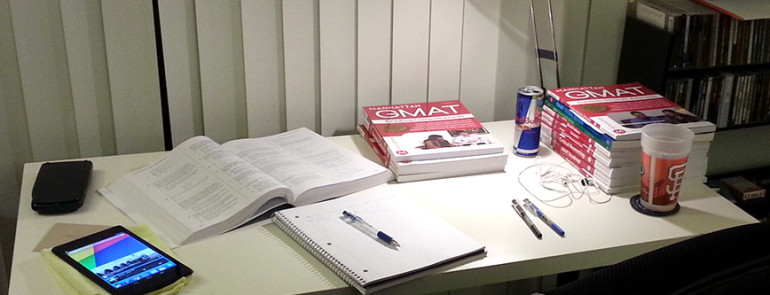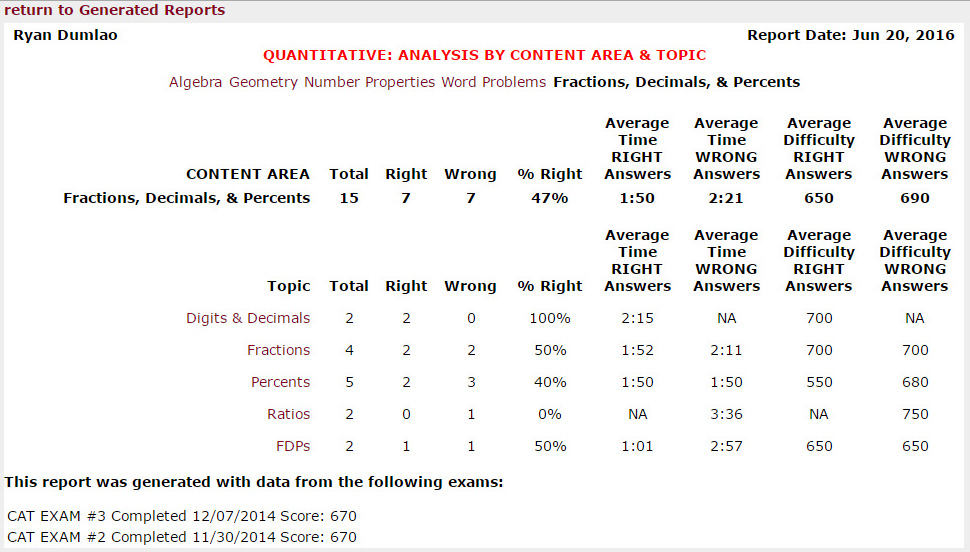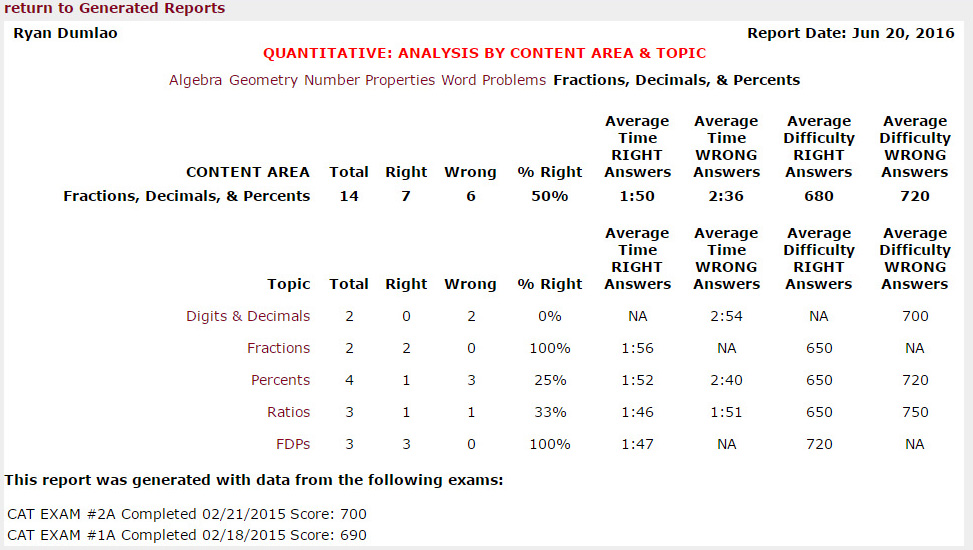Part 2 of the GMAT: How I tackled the GMAT and improved a disappointing score
Apologies for the month gap. I went on vacation and had to finish up a good deal of prep work for Anderson. But this will continue with far more frequency! In this entry I’ll go over the general strategy I used to study for the GMAT, how I rebounded from a bad first test, and what I think was most effective in improving my score.
Just a note, since I had most trouble with quant, most of what I write here will reflect my experience improving my quant score; however, in general these tips should apply to both verbal and quant.
Effective Studying
Best utilizing your resources in order to understand your weaknesses is one of the core differences between a 650 and a 700. Manhattan had a great method to examine my CAT performance through the types of problems, and break down each category and subcategory (Geometry > Triangles, Word Problems > Statistics, Sentence Correction > Parallelism, etc). To that end, effectively using the Manhattan GMAT CAT tests and the Assessment Reports that they give are what gave me an edge. Combine that with excessive problem drilling based on those reports, and I had a decent recipe for success.
Drill, Baby, Drill!
The key to keeping your attack fresh and efficient on any of these subjects is drilling. That doesn’t mean to just do problems and spend hours trying to figure them out, though. You need to use the repetition of drills effectively as well. This is where it is essential to learn and understand the problem strategies that your resources put forth. Each category of GMAT problems defined by Manhattan (and all other test prep programs) has a general strategy developed by common knowledge, patterns and Manhattan’s curriculum to use. Go through these back and forth, do the practice problems given to solidify them, and know how to use them without looking them up. Once you get comfortable using these, then it’s time to drill! Attack the OG problem sets with a timer – give yourself two or three minutes max, and eventually try to do 60 seconds for quant problems and 90 seconds for verbal problems (you’ll inevitably spend more on harder problems, but trying to push yourself to think faster is best while drilling). This method forced me to recognize the type of problem in front of me and immediately pull up the right strategy to tackle it, saving precious seconds. If you have to sit and think about the math for more than 20 seconds, it may be worth it to move on. Don’t look up the answers until you’ve done 10-15 problems in a row in under 15 minutes.
The second part of this process is to assess how you did, which is always the hardest. I remember breezing through 30 or so problems, and then afterwards going down my list of answers with the answer key and marking O (sweet!), O (nice.), O (damn, I’m good), X (crap), O (better), X (another one?), X (AGH), etc. Coming to terms with my initial perception of how I felt I did, compared to how I actually did, took a little while because I kept giving myself a pass by saying:
– I was just making careless mistakes
– I really knew what the right method/answer was
– I’d definitely figure it out better during the real test, I was too relaxed
– It was an anomaly
In reality, it’s not excusable or an anomaly; if you got it wrong in this environment, you’re not going to magically figure it out and correctly answer it during test day. Pressure is not going to drive you to do better on these. You really need to understand fundamentally why you made a mistake, and how to correct your thinking. Look at your weak problem types, go back to the strategies on how to tackle them, find a better way to quickly solve these problems, and drill some more.
First Failure
The first time I took the test, I got the “drill!” part down, but didn’t put much weight into truly understanding the minutiae of problems that I got wrong. As a result, I kept doing broad ranges of problem types, over and over, and unbeknownst to me my stronger categories stayed strong and kept my score afloat while my weaknesses stayed weak and never let me truly improve. My CAT diagnostics stayed near the 670 range, and I kept reasoning with myself that I’d do better on test day, and that Manhattan CATs were notoriously more difficult than the actual test. I had the general strategies down in my head, I had a decent pace at attacking problems, and I figured I was ready.
Test day came and I was nervous. To understand how I operate, I’ll give some info. I’m a night owl; I stay up until 1-2am every night and struggle in the mornings to get my day started. I’m a caffeine fiend but by the time the sun sets I’m usually my most productive with or without it. All of my GMAT studying was done after work, and all my CAT tests were done in the evenings after I had a full day of work.
With that said, when I scheduled my first test I set it at 8AM on a Wednesday. Given my profile above, this was not my optimal time for brain function. I slept early, woke up early, had a cup of coffee, took BART to Oakland’s test center and got started. I was tired, wired on coffee and clearly not in my zone. I had several moments during quant where I struggled to remember the correct approach for a problem, felt jittery, or got so lost in my thought process that I had to clear my test board and start a problem over. I rushed through the last few problems as a result. When I hit “FINISH”, I already knew I wasn’t going to do well. The number came up. 640. My heart dropped. I couldn’t even crack close to my diagnostic scores. What do I do?
Re-approaching Studying: CAT test strategies
I wasn’t crushed, because I knew I could have done better if I had been in a far better state of mind, so that was the first factor to eliminate. I re-scheduled another exam 2 months later. This time I set the test at 4:30PM on Thursday, because I realized I was at peak brain function during the latter part of my days. Then I set out to figure out my actual weaknesses on the exam.
The first thing I did was go back to my CAT exams on the Manhattan site and use the Assessment Reports. These allow you to select one or more of your previous tests and get a full breakdown of your performance, sorted by problem category, subcategory, and difficulty, as well as evaluate your timing on each problem. With the assessment reports, I was able to see that I spent way too much time on certain problem types, and the time I spent on problems I got wrong were considerably longer in many cases. This is a fact of the test, though, so I decided to concentrate on two things:
1) Singling out my weakest problem types and concentrating my studying on them
2) Recognizing when to blow off a problem I’m stuck on and move on
Take the chart above, for example. in Fractions, Decimals and Percents, I did horribly in Ratios and FDPs. My average times for wrong problems in those two subcats were around 3 minutes or more; moreover, the difficulty level for my wrong answers in the whole category were relatively low – 700 or below. I spent a few days poring over the strategies for these two subcats, and drilled myself on these types of problems until I felt I had a far more intuitive mental response when they popped up in front of me. I also kept a mental count in my head of how long I was spending on a problem; if I hadn’t skipped or guessed in a while, I would decide to just pick an answer and move on. The hit from a wrong answer is always better than the hit from missing questions when the test ends. I did this over two rounds of CATs, in every subcat that I felt was weak, and was able to increase the difficulty level of problems that I got right and wrong. I didn’t always get them at a better right-to-wrong ratio, but since the problem difficulties were higher, and I was spending less time on wrong problems, it was a better indicator for me that I was in a better place.
You can see from the table above the improvements in time spent as well as average difficulty on wrong answers. I concentrated on wrong answers because I felt better getting answers wrong in the 720-750 range than getting them right in the 650 – 700 range; they indicated that I was at a higher overall problem difficulty throughout the test.
So just in general, you can see how targeted evaluation of your CAT performance can help push you above where you were on a baseline or first-run of the GMAT. This is probably what all the thousand-dollar courses work with you on, but since I was running at this on my own, this is what I learned was the difference between mediocre studying and truly effective studying.
CAT test types
Just a quick note on these practice tests – I have heard consistently around the web and on GMAT club that the Manhattan CATs are a tick harder than the actual GMAT or its official diagnostics. While my highest score on a Manhattan CAT was 700, my scores on the two free GMAT tests from the official GMAC application were 720 and 740. So take your results from these practice tests with the caveat that none are truly representative of how you’ll truly do on the test, but will give you a decent figure as to what shape you’re in.
Extra Resources
In addition to all this studying, I used a few Android GMAT apps to do on-the-fly GMAT problems while I commuted since I took the train to work. These were questions that I did purely in my head and helped to sharpen my response time and approach. At publication time of this article I can’t remember which ones I used (I’ll need to dig up my old phone to find them), but I’ll update this section later with what I used. In general you should be conditioning your brain to recognize and solve these problems, as well as memorizing common patterns of numbers and rules that are laid out in most test prep programs / books, anytime that you’re not actually studying or working. Get your mind into the GMAT zone and approach everything with some type of logistical, problem-solving methodology to keep your brain fresh.
Redemption Test Mode
2 months later, and my chance at redemption came. After feeling far more prepared, confident and ready to go, I went about my week and days as normal. I planned a celebratory (or consolation) dinner with a friend immediately after the test to have something to look forward to. I gave myself one day of complete brain rest on Wednesday; went to work, came home, watched some TV, went to sleep a little earlier. On Thursday I woke up, went to work, and had a normal day. I left an hour early and got to the test center and jumped right into the exam, no caffeine (except my morning coffee at work), calm and alert. My mindset going in was far better than the first time. I got through IR and Verbal just fine, and then came quant. I took a deep breath, yawned to slow my heart down Apolo Ohno style, and went to task. 75 minutes later, I came out feeling far better. I hit “FINISH” and saw the screen: 710. I almost screamed out in joy at that moment, but realizing Pearson VUE would have probably kicked me out, I simply threw a silent fist in the air and called the proctor to pull me out, grinning ear to ear.
If at first you don’t succeed…
Try again! And again! Really, one bad first experience should not discourage you from your true abilities. Perhaps it’s your study approach. It could be the circumstances of when you took the test. It could just be that you weren’t quite ready. But my experience showed me that a targeted study approach, calm nerves and possibly the familiarity of the process and test center that comes with a 2nd try can give you quite the bump up to what you wanted – 70 points in my case.
As a side note, I had a few stumbles during the 2nd exam still, and I knew in my heart I could probably have done 10-20 points better. But I didn’t want to touch this damn test again and wanted to move on with my life and app process, so I trusted the rest of my application to carry me after this point. The GMAT is getting more and more competitive, so recognize where you feel your cut-off point is and don’t get too obsessed with your score on this exam. You have a whole application for bschool, and this is just a portion of it.
Good luck!







Impressive blog, Ryan!